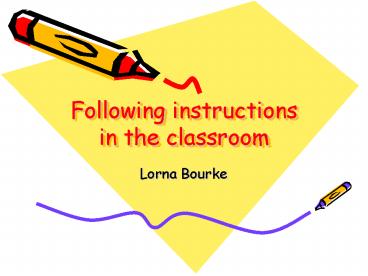Following instructions in the classroom PowerPoint PPT Presentation
Title: Following instructions in the classroom
1
Following instructions in the classroom
- Lorna Bourke
2
What is INSTRUCTION?
- direction a message describing how something is
to be done - education the activities of educating or
instructing activities that impart knowledge or
skill - teaching the profession of a teacher
3
Cognitive skills and Instruction
- What cognitive skills would be required to take
instruction from others? - Memory
- Capacity
- Serial order
- Recency and Primacy effects
- Semantic memory
- Prospective memory
- Maintenance and retrieval
- Attention (Concentration)
- Focus
- Regulation
- Monitoring
- Inhibition
- Sustained attention
- Language
- Comprehension
- Vocabulary
- Are the above skills what we might broadly term
ORGANISATIONAL skills?
4
Working memory and instruction
- Gathercole, Lamont, Alloway (2005)
- Observational Study
- Frequently observed working memory failures in
the classroom - Forgetting instructions
- Forgetting recent events/ information
- Place-keeping errors in complex tasks
- Failing to meet simultaneous processing and
storage demands, such as counting words in a
sentence or detecting missing numbers in a
sequence - These failures in the classroom can hinder a
child from making - normal scholastic progress.
5
Dyspraxia
- Learning, thought and memory
- Difficulty in planning and organising thought
- Poor memory, especially short-term memory. May
forget and lose things - Unfocused and erratic. Can be messy and cluttered
- Poor sequencing causes problems with maths,
reading and spelling and writing reports at work - Accuracy problems. Difficulty with copying
sounds, writing, movements, proofreading - Difficulty in following instructions, especially
more than one at a time - Difficulty with concentration. May be easily
distracted - May do only one thing at a time properly, though
may try to do many things at once - Slow to finish a task. May daydream and wander
about aimlessly
6
Neuropsychological Evidence
7
Reading List
- Gathercole, S.E., Lamont, E., Alloway, T.P.
(2005). Working memory in the classroom. In S.
Pickering (Ed.). Working memory and education.
Elsevier Press. - http//www.york.ac.uk/res/wml/ArticlesTeachers.htm
PowerShow.com is a leading presentation sharing website. It has millions of presentations already uploaded and available with 1,000s more being uploaded by its users every day. Whatever your area of interest, here you’ll be able to find and view presentations you’ll love and possibly download. And, best of all, it is completely free and easy to use.
You might even have a presentation you’d like to share with others. If so, just upload it to PowerShow.com. We’ll convert it to an HTML5 slideshow that includes all the media types you’ve already added: audio, video, music, pictures, animations and transition effects. Then you can share it with your target audience as well as PowerShow.com’s millions of monthly visitors. And, again, it’s all free.
About the Developers
PowerShow.com is brought to you by CrystalGraphics, the award-winning developer and market-leading publisher of rich-media enhancement products for presentations. Our product offerings include millions of PowerPoint templates, diagrams, animated 3D characters and more.

